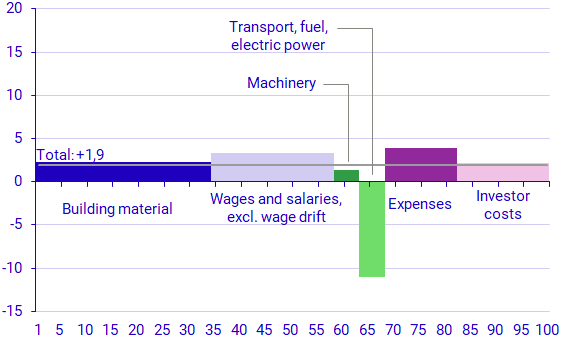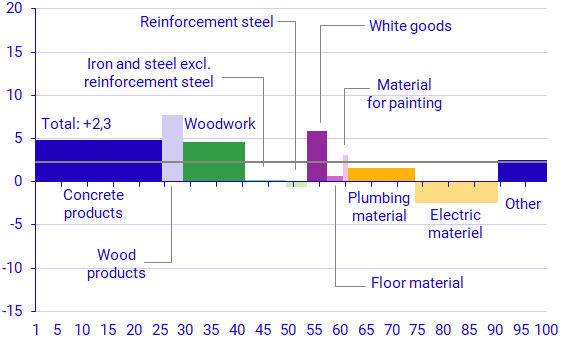Construction Cost Index for buildings, July 2024
Slight decline in the Construction Cost Index in July 2024
The Construction Cost Index for multi-dwelling buildings decreased by 0.3 percent in July compared with June 2024. The annual rate of change in the Construction Cost Index was 1.9 percent in July, compared with the corresponding month in 2023 (2.7 percent in June).
In brief
- The costs of electricity decreased by 6.3 percent between June and July 2024.
- The cost of diesel oil increased by 1.4 percent in July compared with June 2024 but were 17.9 percent lower compared with the corresponding month in 2023.
- The annual rate for costs of reinforcement steel continues to fall.
| Index | Change in percent | |||
|---|---|---|---|---|
| July | June 2024– July 2024 |
July 2023– July 2024 |
||
| Contractors' costs (82%) | 142.4 | ‑0.1 | 1.9 | |
| Construction clients' costs (18%) | 192.7 | ‑0.8 | 2.1 | |
| Total Construction cost index (100%) | 151.4 | ‑0.3 | 1.9 | |
Changes in the last month
The Construction Cost Index for multi-dwelling buildings decreased by 0.3 percent between June and July 2024. This decrease was due to the fact that contactors’ costs and construction clients’ costs decreased by 0.1 percent and 0.8 percent respectively. These two groups account for 82 percent and 18 percent, respectively, of the Construction Cost Index.
The decrease in contractor’s costs was largely due to the fact that costs in the group ‘transport, fuel and electricity’ fell by 0.8 percent. Within that group, the costs of electricity decreased by 6.3 percent, while the cost of diesel oil and transport increased by 1.4 percent and 0.3 percent respectively. The costs for wages and salaries, machinery and remained unchanged.
Contractors’ costs for building materials decreased by 0.1 percent. All costs in the building material groups fell slightly or remained unchanged, with the exception of woodwork, plumbing material and wood products, which increased. The costs of woodwork increased the most, which rose by 1.0 percent.
Construction clients’ costs consist of interest and credit costs, costs for plans, and central administration. The decrease was due to the fact that interest costs and costs for central administration decreased by 1.6 percent and 0.1 percent respectively.
Changes in the last year
The Construction Cost Index for multi-dwelling buildings increased by 1.9 percent between July 2023 and July 2024. It is the lowest annual rate of change since December 2020. Contractors’ costs rose by 1.9 percent, which led to an upward contribution to the Construction Cost Index of 1.4 percentage points. Construction clients’ costs increased by 2.1 percent, which led to an upward contribution to the Construction Cost Index of 0.5 percentage points. The increased construction clients’ costs was largely due to higher costs for official employee wages and costs for plans.
Contractors’ overhead costs and costs for wages and salaries increased by 3.9 percent and 3.3 percent respectively, while costs for machinery rose by 1.3 percent between July 2023 and July 2024. Contractors’ costs in the group ‘transport, fuel and electricity’ decreased by 11.0 percent. Within that group, the costs of electricity and diesel oil decreased by 35.3 percent and 17.9 percent respectively.
Contractors’ costs of building materials increased by 2.3 percent between July 2023 and July 2024. All costs in the building material groups rose, with the exception of electric material and reinforcement steel, which decreased by 2.4 and 0.7 percent respectively. The costs of wood products and white goods increased the most, by 7.7 percent and 5.9 percent respectively.
Construction Cost Index for multi-dwelling buildings, excl. wage drift and value-added tax.

The width of the bars represents the production factor’s weight share in percent in the calculation of the Construction Cost Index for multi-dwelling buildings. The height of the bars represents the average price development of each production factor.
| Goods | Change in percent | ||
|---|---|---|---|
| June 2024– July 2024 |
July 2023– July 2024 |
||
| Wood products | +0.3 | +7.7 | |
| White goods | ‑0.1 | +5.9 | |
| Concrete products | ‑1.0 | +4.8 | |
| Woodwork | +1.0 | +4.6 | |
| Material for painting | 0.0 | +3.1 | |
| Other building materials** | ‑0.6 | +2.5 | |
| Plumbing material | +0.5 | +1.6 | |
| Floor material | ‑0.0 | +0.6 | |
| Iron and steel* | ‑0.1 | ‑0.2 | |
| Reinforcement steel | 0.0 | ‑0.7 | |
| Electric material | ‑0.0 | ‑2.4 | |
| Total building materials | ‑0.1 | +2.3 | |
* Includes reinforcement steel. ** Includes materials for thermal insulation, garbage equipment, gypsum and wood-based boards.
Construction Cost Index for multi-dwelling buildings, excl. wage drift and value-added tax

The width of the bars represents the construction material group’s weight share in percent of all construction material in the calculation of the Construction Cost Index for multi-dwelling buildings. The height of the bars represents the average price development of each product category.
Next publishing will be
2024-09-16 08.00.
Statistical Database
More information is available in the Statistical Database
Feel free to use the facts from this statistical news but remember to state Source: Statistics Sweden.
